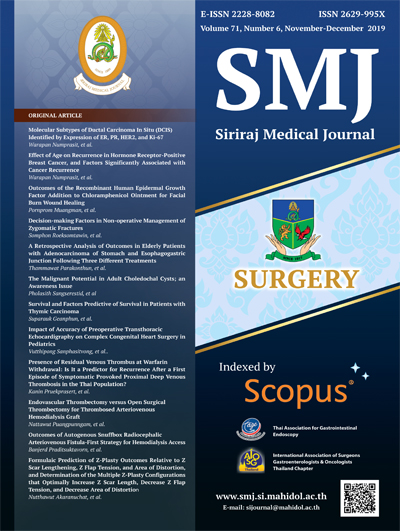Retrospective Analysis of the Outcomes in Elderly Patients with Adenocarcinoma of the Stomach and Esophagogastric Junction Following Three Different Treatments
DOI:
https://doi.org/10.33192/Smj.2019.68Keywords:
Stomach neoplasms; gastrectomy; aged; mortality; esophagogastric junctionAbstract
Objective: To compare survival outcomes and complications in elderly patients who underwent three different treatments.
Methods: The data of patients aged 70 years old or older diagnosed with adenocarcinoma of the stomach and esophagogastric junction (Siewert types II and III) between January 2005 and December 2016 were reviewed. The results of different treatments and risk factors for post-treatment morbidity and mortality were analyzed.
Results: In total, 220 elderly patients were included: 102 (46.4%) who underwent curative intended gastrectomy with radical lymphadenectomy (Curative group), 62 (28.2%) who underwent non-curative surgery or endoscopy (Non-curative group), and 56 (25.4%) who received best supportive care (BSC group). Mean ages were 76.6, 78.1, and 78.7 years old, respectively (p=0.596). Median overall survival was 32, 5, and 3 months, respectively (p<0.001). In the curative group, overall survival was associated with the pathological stage (p=0.017), but not the resection category (p=0.298). Concerning the curative and non-curative groups, severe post-treatment complications occurred in 14 (8.5%) patients (7.8%, curative group; 9.7%, non-curative group). Severe post-treatment complication was associated with age ≥80 years (p=0.023) and coronary artery disease (p<0.001); however, multivariate analysis identified coronary artery disease as an independent risk factor for severe post-treatment complication. 5 (3%) patients had in-hospital mortality, associated with age ≥80 years old (p=0.039) and coronary artery disease (p=0.005).
Conclusion: Curative and non-curative procedures can be safely performed in elderly patients. However, caution should be taken with extreme elderly patients, especially those with coronary artery disease. Best supportive care should be considered only for unfit patients.
Downloads
Published
How to Cite
Issue
Section
License
Authors who publish with this journal agree to the following conditions:
Copyright Transfer
In submitting a manuscript, the authors acknowledge that the work will become the copyrighted property of Siriraj Medical Journal upon publication.
License
Articles are licensed under a Creative Commons Attribution-NonCommercial-NoDerivatives 4.0 International License (CC BY-NC-ND 4.0). This license allows for the sharing of the work for non-commercial purposes with proper attribution to the authors and the journal. However, it does not permit modifications or the creation of derivative works.
Sharing and Access
Authors are encouraged to share their article on their personal or institutional websites and through other non-commercial platforms. Doing so can increase readership and citations.















